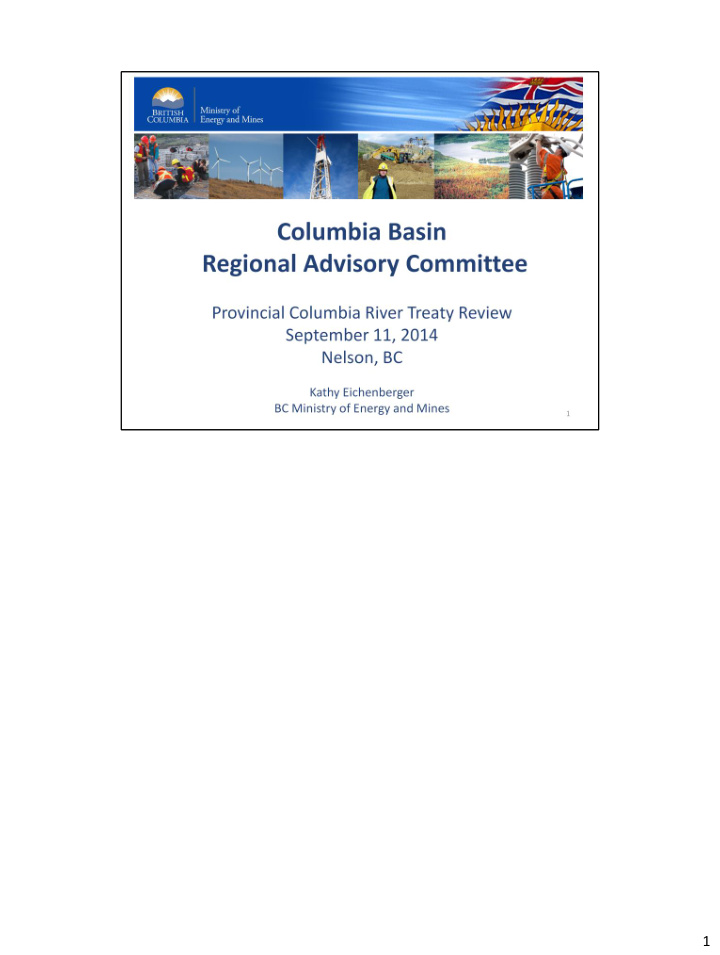



1
2
Studies, negotiations and project selection took over 20 years with the primary objective of maximizing the benefits of power and flood control. The Treaty was signed in 1961 and ratified in 1964 for a couple of reasons. Ratification in Canada delay due to the need to: Negotiate Canada - BC Agreement to transfer benefits and obligations to BC Negotiate sale of power benefits for 30 years to Pacific Northwest utilities 3
Non-Treaty Storage extra 5 MAF Assured flood storage 8.45 MAF 4
• The first 30 years of CE was sold by BC to a consortium of US utilities for an up front price of US$254.4 million • CE based on Annual Operating Plan 5 year ahead calculation of 50% of potential power production due to coordination of Treaty flows at the border to maximise power production. • Current CE approx. worth about $100-200M/yr • The US bought 8.45 Maf of “primary” flood control up to 2024 for $64.4 million • Called Upon is not well defined: disagreement on which dams, when and how. 5
6
7
8
9
10
11
12
13
14
• The Treaty has brought significant benefits to both countries and we believe the value of upstream regulation is only going to increase over time. • Today these benefits extend to other values that the Treaty didn’t explicitly recognize, such as ecosystem – salmon enhancement, water supply, navigation, recreation and others. • For example, in dry periods Canadian storage is drafted first for power purposes but this provides additional benefits to other interests in US • There continue to be impacts to Canadian interests from ongoing Treaty operations - some reservoirs fluctuating by as much as 155 ft • Still very strong feelings around the Treaty in the Canadian Columbia Basin. • Value of benefits needs to be assessed in today’s terms. The Treaty is not just about power and flood control anymore – it touches all aspects of trans-boundary water management • Valuation of US benefits is underway; need to address this in a rational manner – not positional or emotional • Although there are benefits associated with the Treaty, there were also many negative impacts due to historic dam and reservoir construction: these issues remain top of mind for many Columbia Basin residents, old and new. • Impacts are ongoing due to reservoir operations to meet Treaty requirements, e.g. operations at Arrow Lakes Reservoir primarily serving US Flood Control needs 15
• Changing flood control provisions to an ad hoc system creates unnecessary impacts from the planned storage and flood control operations that the U.S. currently enjoys • Impacts and risks from lowering U.S. reservoir levels to fisheries, water supply, navigation; risk of not achieving refill • Disagreement centers on: at what flood risk, which reservoirs, when to call • BC interpretation based on wording in Treaty • Predicted climate change impacts on hydrology: total annual inflow in BC basin same or higher; in U.S. 20-40% less total annual inflow predicted. Some climate change scientists predict that 60% of Columbia River flow will come from BC in future 16
• Adaptive management should be included in Treaty discussions with enough certainty for planning purposes but with a realization that things can change: new science, different economic and energy conditions, changing societal values • Changes to Treaty operations have been made to benefit ecosystems and further improvements can be investigated – no need to change the Treaty framework • Upstream regulation will become even more important to mitigate climate change impacts – extreme events, floods and droughts • Continued engagement is a priority for First Nations, local governments and the public – e.g. Columbia Basin Regional Advisory Committee 17
• Test runs are sequential – not all operating considerations modelled at once 18
19
20
21
• US Army Corps of Engineers does not want to increase flood risk US decision is not expected before mid-term elections • Negotiating process, if any, is not defined nor developed 22
• Gain a further understanding of U.S. perspectives and next steps in U.S. process 23
24
Recommend
More recommend